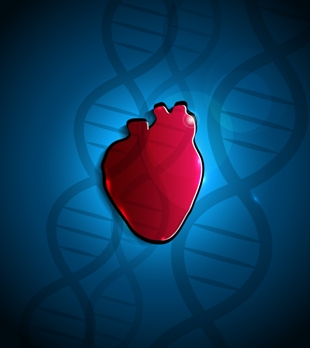 Six weeks after intricate surgery to replace an aneurysm at the juncture of my heart and aorta with a polyester graft, I’m almost back to normal. I’m walking a lot, about to start biking again, and I’m well on my way to a complete recovery. But there is still a nagging question: Does my family history of aortic catastrophes have implications for the next generations of the Norman family?
Six weeks after intricate surgery to replace an aneurysm at the juncture of my heart and aorta with a polyester graft, I’m almost back to normal. I’m walking a lot, about to start biking again, and I’m well on my way to a complete recovery. But there is still a nagging question: Does my family history of aortic catastrophes have implications for the next generations of the Norman family?
My paternal grandmother died from an aortic rupture. My father was felled at the age of 67 by what was diagnosed as a heart attack, but some of the symptoms sounded like an aortic dissection—an aneurysm that eventually resulted in a breakdown of the aortic wall. And in 2002, my brother survived an aortic dissection, thanks to an astute diagnosis and skillful surgery at the Karolinska Institute in Stockholm. It sounds like a family affliction, but it could all be coincidental.
 My grandmother had chronic hypertension and atherosclerosis, which could have caused an aneurysm in her abdominal aorta, the part of the aorta that runs from the chest cavity to the lower limbs. It’s relatively common in older people. (We don’t know where her aorta ruptured.) My father also had chronic hypertension that could itself have resulted in an aortic aneurysm and dissection—or he may simply have had a heart attack. And my brother and I could have succumbed to elevated blood pressure exacerbated by the stresses of demanding jobs. A more likely explanation, though, is that our family has a genetic condition that has made some members prone to weaknesses of the aorta.
My grandmother had chronic hypertension and atherosclerosis, which could have caused an aneurysm in her abdominal aorta, the part of the aorta that runs from the chest cavity to the lower limbs. It’s relatively common in older people. (We don’t know where her aorta ruptured.) My father also had chronic hypertension that could itself have resulted in an aortic aneurysm and dissection—or he may simply have had a heart attack. And my brother and I could have succumbed to elevated blood pressure exacerbated by the stresses of demanding jobs. A more likely explanation, though, is that our family has a genetic condition that has made some members prone to weaknesses of the aorta.
Half a dozen inherited syndromes have long been associated with high risk of aortic aneurysms and possible dissection or rupture. Patients with these syndromes have a variety of other conditions in addition to weaknesses of the aorta. The most common is Marfan syndrome, which is characterized by, among other things, long limbs, fingers, and toes; flexible joints; and skeletal abnormalities. A more recently diagnosed disorder, Loeys-Dietz syndrome, also predisposes patients to various skeletal and connective tissue problems. The genetic underpinnings of these syndromes are well established—more than 1500 mutations in a large gene that codes for a protein called fibrillin-1 have been identified in Marfan patients, for example.
No member of our family, including my brother and me, has any of the signature features of Marfan, Loeys-Dietz, or any of the rarer syndromes associated with aortic problems. But we may still have inherited genetic mutations that result in weaknesses in the aorta, especially the thoracic aorta, the part of the blood vessel that resides in the chest cavity and is subjected to stress from the pounding heart. In fact, about 20% of patients who have a thoracic aortic dissection, but no other characteristics of the syndromes associated with aortic weaknesses, have a family history of aortic aneurysms or dissection. That suggests genetic abnormalities different from those that underlie the known syndromes may be at play in these families.
An intense hunt for those genetic abnormalities has so far identified mutations in five genes. Together, they account for about 20% of cases of familial thoracic aortic aneurysms and dissection (usually shortened to familial TAAD). That means genetic mutations have yet to be identified in 80% of familial TAAD cases, and an unknown percentage of those could be simply due to other risk factors, such as smoking and high blood pressure. The most common mutations identified so far involve a gene called ACTA2 that codes for a protein called smooth muscle alpha-2 actin, a component of cells found in the walls of arteries. Some others involve the same genes that underlie Loeys-Dietz syndrome, suggesting some common pathways in the development of aneurysms.
These genetic findings are giving researchers insights into the cellular mechanisms that cause aortic aneurysms to form and eventually break down. And they have also begun to influence treatment and timing of surgery. Some mutations, for example, are associated with more rapid enlargement of aneurysms and swifter progression to aortic dissection or rupture; early surgery in those cases is now recommended. And knowledge of the cell signaling pathways in Marfan syndrome has led to promising clinical trials of a common blood pressure drug called losartan that appears to slow the growth of aortic aneurysms in Marfan patients.
How does all this affect our family? Very little if the aortic problems that have afflicted my brother and me don’t have a genetic basis. But if an inherited genetic mutation is to blame, then the implications could be more worrisome. Familial TAAD is inherited in what is known as an autosomal dominant pattern: A mutated gene inherited from only one parent would result in an increased risk of developing thoracic aortic aneurysms. (Recessive inheritance, in contrast, requires the inheritance of defective genes from both parents for a condition to be manifest.) That means each of our daughters (we have only daughters) would have a 50% chance of inheriting a gene that increases her risk of aortic aneurysms. But even then, the risk is just that—a risk, not an absolute. Indeed, many people with mutations that raise risks of developing aortic aneurysms remain aneurysm-free. Welcome to the fuzzy and confusing world of human genetics.
I have an appointment early next year with Dr. Harry Dietz (the Dietz of Loeys-Dietz syndrome) to discuss our family history and possibly undergo genetic testing. That could pinpoint a genetic basis of our family’s aortic problems—if they have a genetic basis. But since 80% of familial TAAD cases have no known causative mutations, the odds are against it.
For our daughters, echocardiogram imaging—a noninvasive ultrasound procedure—repeated at regular intervals would indicate any enlargement of the aorta. And as understanding of the cellular mechanisms advances, targeted treatments should slow progression of any nascent aneurysms. Ultimately, although I wouldn’t recommend the experience, surgery is already highly effective and is likely to improve. But we’re talking years or decades down the road, and with luck, no treatment or surgery will be required.
For me, it’s hard to escape the thought that I may have passed on an increased risk of aortic problems to my daughter. Of course, that kind of thinking—especially the tinge of guilt that goes along with it—is exactly what every genetic counselor says you should avoid. We all inherit a genetic endowment that includes a variety of heightened and lowered risks. And any heightened risk associated with aortic aneurysms can be monitored, perhaps treated eventually, and if necessary excised. That, at least, helps assuage that nagging guilt.
§
This is the fifth in a series. Part 6 comes in a week, on Monday, 11/10: An Incident in the Pancreas
__________
Colin Norman has been a science journalist for more than 40 years. He is the former news editor forScience magazine and currently lives in Lewes, Delaware.
__________
Photos: photo album – Vladimir Volodin; heart/DNA – GRei; both via Shutterstock
One thought on “Guest Post: Affair of the Heart: V. A Family Matter?”
Comments are closed.